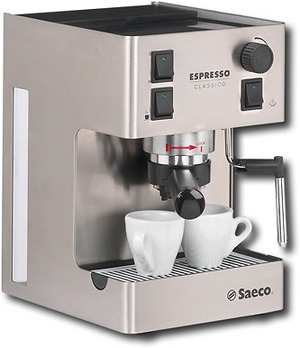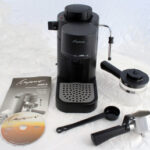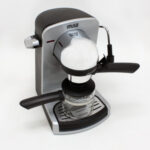I hope whoever coined the phrase “thou shalt not worship false idols” wasn’t thinking about cappuccino when he wrote it. Because if there is eternal damnation associated with worshipping cappuccino, I’m going to be in big trouble one day. Cappuccino greets me every morning with its cinnamon speckled froth atop steamed milk and pungent, precious brew with its caramel-hued crema; it startles me into wakefulness when my own body can’t master the task. Worshipping it only seems natural. And the best cappuccino I’ve made at home is a product of my current espresso machine, the Saeco Espresso Classico Machine (Model 30061). The Saeco Espresso Classico Machine is a serious espresso machine, not intended for amateurs. If you want to know whether this homemade cappuccino tops coffee bar cappuccino, read on.
The Saeco Espresso Classico Machine is a pump driven model with a 96 ounce, removable water tank. And to make proper cappuccino or espresso, that water is essential. An optimal cappuccino or espresso requires not only quality espresso beans, but also fresh water (and milk for cappuccino), all handled with precision. Before making a cup of cappuccino or espresso with the Saeco Espresso Classico Machine, the manufacturer recommends priming the pump, that is, opening the steam knob and allowing at least 4 ounces of water to pour out. The purpose of priming the pump is to ensure there is enough water throughout the system to make an optimal cup of cappuccino or espresso. After priming the pump, and before putting the ground coffee into the filter basket, the manufacturer recommends placing the cup(s) to be drunk from under the empty filter basket and running the machine until the cup(s) are almost filled with hot water. Let those cups sit for a few minutes until they’ve absorbed the heat from the water, then empty the water and place the cups on the warming plate atop the machine. Once the cappuccino or espresso is made, the pump should be primed again. So you can see that the water requirements for one cup of cappuccino or espresso substantially exceed the water used in what you actually drink. This is why that 96 ounce water tank in the Saeco Espresso Classico Machine is so handy.
Another desirable feature of the Saeco Espresso Classico Machine is the pannarello frothing attachment. This is the attachment used to froth milk for cappuccino. It turns around 180 degrees, which is useful both for using different type cups and for turning the attachment over the drip pan during priming and after use, when some unnecessary dripping inevitably occurs. The Saeco Espresso Classico Machine pannarello frothing attachment comes apart easily for cleaning. After more than a year of daily use, the Saeco Espresso Classico Machine still makes a good froth, whereas cheaper machines often have begun to act unreliably by this time.
Saeco began in Italy in 1981 and is now a world leader in producing and selling espresso and other coffee machines. Its prominence in the coffee maker market is well deserved, for Saeco makes a superior machine. There are two small details of the Saeco Espresso Classico Machine that could be improved, neither of which affects the taste of the cappuccino or espresso. The Saeco Espresso Classico Machine has a screw in the brew head that needs to be unscrewed so the machine can be taken apart for occasional cleaning. This is cumbersome. The other minor flaw in the Saeco Espresso Classico Machine is probably no flaw at all outside the United States where we tend to supersize everything. The distance from the pannarello frothing attachment to the counter does not easily permit the use of large drinking vessels. Ok, this is not a big deal, and the cappuccino fanatic can easily work around it to produce a mega-cappuccino. It just takes a bit more effort.
The Saeco Espresso Classico Machine retails for $395 and up. The wise cappuccino lover will seek out sales in high end department stores where it can often be had for a more satisfactory price. Advice to those who have to date struggled with $50 models of espresso makers and wonder whether the investment in a serious espresso maker like the Saeco Espresso Classico Machine is worthwhile? It depends on how good a cup of cappuccino or espresso you require, how often you drink cappuccino or espresso, and how long you expect the machine to work. Those cheaper models (and I have tried several) do not have the durability of the Saeco Espresso Classico Machine. The cappuccino they produce is more erratic in quality. Over time, the ability of those machines to heat and froth milk adequately deteriorates. The pump models of espresso machine such as Saeco Espresso Classico produce a more appealing crema on a consistent basis.
If you’re a serious cappuccino or espresso drinker, the Saeco Espresso Classico Machine is well worth the investment. Once you buy one, heed the details of making a quality cup of brew. Saeco provides a detailed instruction pamphlet with the Saeco Espresso Classico Machine which is straightforward. For a really great cup of cappuccino, remember to pay attention to the quality of ingredients you use; the temperature of the steamed milk and froth; and the basics of cappuccino and espresso making like priming the pump. Those who are weight conscious will be pleased to learn that skim milk outfroths milk with fat content.
One nice touch is to top off the cappuccino with grated cinnamon or orange peel. Health experts have found that using fresh grated cinnamon (not the powdered form) in coffee offers a health benefit. It also adds a wonderful taste.
And now for the question and answer you’ve all been anticipating. Can you make a cup of cappuccino or espresso that tastes as good as what you buy in your favorite espresso bar using the Saeco Espresso Classico Machine? The answer is yes, as long as you pay attention to the art of espresso making.





